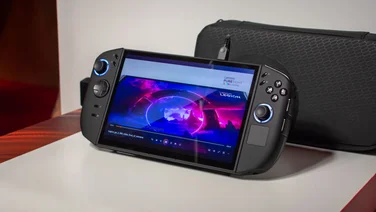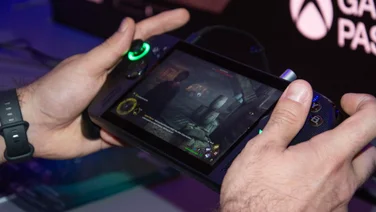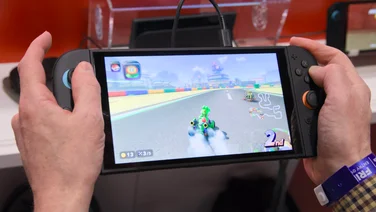To help us provide you with free impartial advice, we may earn a commission if you buy through links on our site. Learn more












- Includes a comfortable headband
- Good colour reproduction
- Sharp pancake lenses
- Native display contrast isn’t close to OLED grade
- Advanced controller tracking can struggle in low light
- Much less powerful than the cheaper Quest 3
The Quest Pro is Meta’s most expensive, prestige VR headset. Released in October 2022, it arrived before the significantly cheaper Quest 3 – which we regarded highly at the end of 2023.
Due to its age, and the Quest 3 releasing recently, the Meta Quest Pro is the VR headset we’re struggling to recommend. While superior to the Quest 3 in some respects, such as colour saturation, build quality and comfort, the newer (and cheaper) Quest 3 has noticeably higher-resolution displays and a lot more power.
Meta Quest Pro review: What you need to know
When the Quest Pro arrived in late 2022, the pitch was that this VR headset was the “serious” one, aimed at businesses and the like. “Connect and collaborate in VR like never before” says the Meta blurb.However, that’s not quite the reality. The Meta Quest Pro comes across a higher-end take on the formula established by the Quest 2 and its predecessors. It still excels more at the fun and frivolous than it does at work.
It does have colour pass-through, letting you see the world around you when you need to. And its design is a little more convenient for times when you need to be aware of what’s around you.
Like the other models in this series, the Quest Pro is a standalone headset. It has its own processor, storage and app store baked in. However, you can also connect it to a PC (cabled or wireless) for higher-end VR experiences than the smartphone-like CPU can handle.
READ NEXT: Best VR headsets
Meta Quest Pro review: Price and competition
The Meta Quest Pro originally cost £1,500, a jaw-dropper back in 2022 when the base Meta Quest 2 was just a fifth of the price. This dropped to £1,000 in March 2023. It’s more reasonable, but still more than twice the cost of the Quest 3.












If you’re new to VR, we would recommend starting with either the Quest 3 or the even cheaper Quest 2 over the Pro. Or perhaps, even, the Pico 4, which sits somewhere between the two lower-end Quests in terms of hardware and capability.
Those waiting for the moment that VR becomes a cornerstone of productivity will need to wait for the likes of the Apple Vision Pro, or the designer-led mixed reality headset announced by Sony at CES 2024.
Meta Quest Pro review: Design and key features
The Quest Pro is the slickest-looking of the Meta VR headsets. It’s black, moody-looking, and the dark colour lets the headset partially hide the cameras dotted around its surface.












It also has a couple of notable elements that the cheaper Quests lack. The Quest Pro has the equivalent of the Elite strap you might pay £70 for in a Quest 3, and a charging dock. Lay the headset and controllers on this pad when you’re done and charging might never be an issue again.
The controllers also feel much more solid than those included with the other Quest headsets. They weigh 164g, compared to 126g for the Quest 3 controllers, and have built-in lithium-ion batteries.












They last eight hours on a single charge, which bears out in testing, but the Quest 2 and 3 controllers last far longer. 30 hours is not unheard of.
Did Meta scrimp on the Meta Quest Pro controller batteries? No, not considering their 2,880mAh capacity. However, they also have a lot more tech squeezed inside.
The Quest 2 and 3 controllers are tracked by the headset using infrared. Meta’s Quest Pro wands have cameras of their own, allowing for standalone tracking of motion and position. It means your hand position can still be tracked above your head or behind your back, which is pretty neat.












It’s not a fool-proof solution, though, as the cameras need light to operate effectively. Use the Quest Pro in a darkened room and you’ll see a pop-up complaining about the light level, which isn’t such an issue with the Quest 3’s IR controllers.
I found they could still operate well in a dim environment, but if you like to play in dark rooms for maxed-out immersion, this tech is not ideal.
The entire fit of the Quest Pro tells you immersion isn’t necessarily a top-billing consideration. This headset has no light-blocking fixture at the bottom of your vision, and the padded blocks to the left and right are easily removable.
Remember, this is meant to be a headset for professional types to use for work collaboration, even if that hasn’t panned out to a groundbreaking extent since the Quest Pro’s release.












I don’t think this is necessarily a huge problem. The side blocks offer very good-light blocking, and it’s perfectly possible to get engrossed – even in a very bright room. Your brain just sort of blocks out the periphery after a short while and besides, if you still struggle, you can also buy full light-blocking attachments.
The comfort here is also miles better than that provided by the standard Quest 3 or Quest 2 straps. The padding is gel-like, the rear part cups your crown and is tightened using a simple rotary dial. Weight balancing is miles better than that of the elastic jockstrap of the cheaper Meta headset, too.
It still takes some finessing, and after one long session without quite the right fit I ended up with a glowing red forehead, but this is not padding you’ll feel the need to upgrade away from.
Meta Quest Pro review: Display
Display tech is in a fairly fast cycle of development at present, and that has left the Meta Quest Pro in an awkward position. Its screen is in some ways much better than the Quest 3’s but in another, it really isn’t.
Resolution is the top issue. The Quest Pro has 1,920 x 1,800 pixels per eye, around seven million in total. The Quest 3 has 2,064 × 2,208 pixels per eye, or around nine million in total.












Both headsets use one display per eye, reducing wasted pixels, and the result is that games and apps can look noticeably more detailed on the Quest 3.
The Quest Pro has slightly sharper lenses (both use a pancake design), but in person, good resolution and good lens sharpness beat average resolution and excellent lens sharpness. At a certain point, increased lens sharpness largely serves to highlight pixel structure in these consumer-grade VR headsets.
Colour and contrast are significantly better in the Meta Quest Pro, though. It can replicate tones of a vividness the Quest 3 and Quest 2 just can’t touch, and it uses a mini LED panel to boost contrast.












These panels have a claimed 500 local dimming zones – basically, screen areas whose brightness can be controlled independently.
In practice, this means the Quest Pro can avoid the distracting effect where the border of the display is very obvious with a glow even when displaying true black. I’ve called it the porthole effect in the past. However, it doesn’t truly improve the contrast of actual sections of the image that much, because the native contrast of the screen still isn’t all that great.












Still, it’s a notable improvement. Developers do have to enable this feature for it to work, but it does have a notable impact on test titles such as 7th Guest and Asgard’s Wrath 2. MiniLED is useful, but not in the same league as the OLED displays of a Sony PSVR 2.
READ NEXT: Best gaming keyboards
Meta Quest Pro review: Performance, features and battery life
The Meta Quest Pro’s core features are similar to those of the Quest 3. It has good built-in speakers. The sound appears much louder to you than to other people in the room (leakage is still significant, however) and the bass is decent considering these function like open-ear headphones.
This was also Meta’s first use of colour passthrough back at its 2022 release, meaning you can see the world around you in full colour – a must for mixed reality applications. The image is quite fuzzy even in decent lighting, and worse in dimly lit rooms.
Unfortunately for the Pro, the Quest 3 performs significantly better in this area. While both passthrough images are quite poor in terms of detail and clarity, the Quest Pro’s picture is significantly noisier and appears at a slightly lower resolution. Meta claims the Quest 3 has “three times the resolution” than the Pro in its pass-through mode, which doesn’t quite represent the actual experience. But, yes, the newer and cheaper headset is again superior.












It does have a couple of standouts not shared with the Quest 3, mind. The Quest Pro has eye tracking, face tracking (of the wearer) and mouth tracking, which is a more recent addition.
You can see this in action in your character avatar visible on the Quest Pro’s home screen mirror. The usefulness of these features are limited by the Quest 3 not using them, though, as it becomes a harder sell for the limited budgets of developers. You can’t even use the potentially brilliant eye tracking in the main interface at the time of review.
The Quest Pro uses Qualcomm’s Snapdragon XR2 Plus chipset, the best available at the time of release. It has since been beaten, though, including by the Snapdragon XR2 Gen 2 of the Quest 3.
The Pro’s XR2 Plus GPU is roughly equivalent to the aged Snapdragon 865 smartphone processor, while the newer Quest 3’s XR2 Gen 2 is closer to the much newer Snapdragon 8 Gen 2.












In games, that extra power may translate to higher or more consistent frame rates versus the Pro. Other titles have been given updates that apply to the Quest 3, but not the Quest Pro. One such title I’ve tested fairly extensively is 7th Guest, which was given a “2K” resolution texture boost on Quest 3 and therefore looks significantly better than it does on the Pro.
If you’re fairly new to VR, you’ll likely come to the Pro expecting “best of the best” results. That’s not how it pans out in 2024, however. Even the Meta Quest 3 is working its way to becoming old news, as Qualcomm has announced the 15-20% more powerful XR2 Plus Gen 2. We don’t know which headsets will use it just yet.












As in the other Quest headsets, the Quest Pro also has a cooling fan. But you’ll likely only notice the noise when you’re pootling around the interface as apps or games are downloading.
Meta says the Quest Pro lasts up to 2.2 hours of “productivity”, 2.6 hours of gaming or 2.9 hours of general use. When playing Asgard’s Wrath 2, a graphically intensive title, it lasted fractionally over two hours.
Meta Quest Pro review: Verdict
The Meta Quest Pro is a very good VR headset that was difficult to recommend to many at launch, and has only become more problematic since, despite its many strengths.
It is the best-built and most comfortable headset Meta makes. It has the best colour reproduction and improved contrast. But for less than half the price you can get the more powerful, higher-resolution Quest 3.
You could even buy a Quest 3, get the hugely expensive Quest Touch Pro controllers separately, plus an improved head strap and still have money left over (going by official pricing). It’s not Meta’s fault as such, just a reminder of how quickly things develop and move on in the world of mobile tech.






